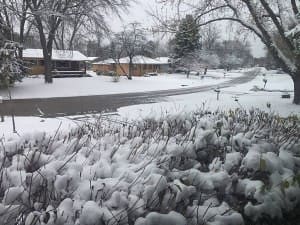It’s windy and cold. A blizzard is raging outside. Everybody’s roof is snow covered and I’m the roofer people call because my reputation for not scaring people precedes me.
Don’t panic.
The cold is your friend right now. Water is in its solid form and as long as it stays frozen, it won’t be coming in. There’s nothing that can be done until the roof can be accessed and it can’t be accessed until after there’s some melting. You can’t fix a leaky roof from the inside, so don’t even try. Your best solution may be to just tarp off the problem area until the spring (if tarping can be done safely), but be sure not to block off any venting pipes that vent out dangerous gasses.
Now is a time when you can start planning if you know where to start.
Identify the potential source of the leak.
Leaks tend to spring up around perforations. A perforation is any place on the roof where there is a break in the shingles. Vents, soil pipes (which exhaust sewer gasses out of house), chimneys, or failing flashing are often the culprits. Valleys, which are where two pieces of roof come together and water tends to be concentrated in those places, are also potential problem places.
Take measurements.
By narrowing down where the leak is coming from, you can narrow down where the potential leak is. First look on the inside where the leak is. Measure from the inside wall to the point of the leak. Add 8 inches for the thickness of the wall (studs, plus drywall, plus exterior siding). Then add in the width of the overhang. Once you add these items together you will have the approximate length from the edge of the roof that the problem is occurring.
Now measure from the leak point down. This is a little more tricky and requires some guess work, but generally you want to be able to approximate the distance from the edge of the roof where the gutter sits, on up to where the leak is.
Dormers are major culprits.
The sides of dormers are often improperly flashed. If that is the case, then water and ice will soak through these areas. If your roof was recently done, your better roofers will have used a rubberized membrane called ice and water underneath the shingles. If they used this along the dormer, this would have helped to protect you as well.
Everybody loves a skylight but….
Skylights tend to be leak points. This can be due to improper installation from the original builder, or it can be because the skylight has failed. Skylights tend to last 10 to 20 years before they start to leak. Skylights are meant to be installed with flashing kits that some builders consider optional. If you had your roof replaced and you have a skylight leaking, it may be because the original builder nailed too close to where the nailing flange meets the vertical part of the skylight. Your skylight may need to be replaced. Installation of skylights can be costly, with installation alone running $1000.
Chimneys
Sometimes the problem is not with the roof at all, but with the chimney. Chimney caps crack over time. Flues chip. Bricks need to be tuck pointed. The winter’s not the best time to do this but you can have a chimney company analyze your chimney. Just remember, that a chimney guy isn’t a roofer just as a roofer isn’t a chimney expert. Their expertise is focused on the chimney. Sometimes the best thing to do is use a plastic shrink wrap around the chimney to avoid water going into the cracks in tuck pointing, but consult a chimney expert.
Don’t be victimized by the blame game.
Look to get advice from a roofer for roofing problems. Get advice from a chimney expert for chimney problems.
Sometimes the problem isn’t where you would think.
Shingled roofs, if properly installed, are laid down in a step pattern. Water will not travel along those steps unless they were not laid down evenly. If a shingled roof is not professionally installed with the step pattern, problems are more likely to occur, but it’s usually pretty obvious when the step pattern was not used.
Rubber roofs on the other hand can be a nightmare to diagnose if there are multiple layers. You just cannot tell where the leak is in many cases until you start to rip off the old roof and discover little under layer rivers of water flowing from areas you wouldn’t even begin to expect the problem to have started.
Ridge caps should be looked at.
The shingles that go over the top of the roof are sometimes shingles that roofers have historically taken shortcuts on. You should be able to see these from the ground. If these ridge cap shingles have degraded and lost a significant amount of their colored granules, you will see mostly just the black asphalt which is what is supposed to protect your home. Sometimes this looks frayed. Although this is a more rare place for leaks, it is a potential leak point. if your cap shingles are degraded.
Now is the time to do your planning.
With the tools in this article, you should now have a good idea of where your roof leak is. Assess the age of your roof. Does it make sense to just replace the whole thing or is it new enough so that if you repair the area of the leak, that the other parts should last for years? Have you assessed your personal finances? Is the age of the roof such that if one area is fixed, problems can just pop up in other areas?
Empower yourself.
Knowledge is power and if you’ve made it to the bottom of this article, you’re better suited to figure out what’s going on with your roof than someone who can’t trouble themselves to do a little research. While this article is not a replacement for having a professional do an inspection, it is a tool. A good roof inspection shouldn’t be more than $200 for a 2500 or less square foot home. A professional will use whatever tools are available to him or her to assess a problem. They may climb up on your roof, use a drone, a camera with a powerful zoom capability, or just a pair of binoculars. The closer up they can see the potential problem, the more likely they will be able to diagnose the problem.


